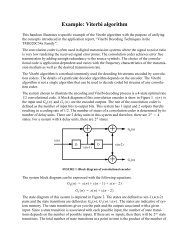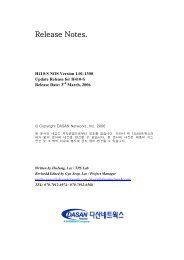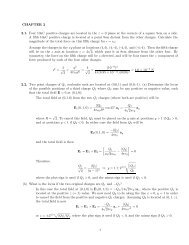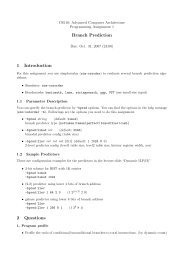ehavior, people still remain locked in defensive reasoning. Either they remain unawareof this fact, or if they do become aware of it, they blame others.There is, however, reason <strong>to</strong> believe that organizations can break out of this viciouscircle. Despite the strength of defensive reasoning, people genuinely strive <strong>to</strong> producewhat they intend. They value acting competently. Their self-esteem is intimately tied upwith behaving consistently and performing effectively. Companies can use these universalhuman tendencies <strong>to</strong> teach people how <strong>to</strong> reason in a new way—in effect, <strong>to</strong> change themaster programs in their heads and thus reshape their behavior.<strong>People</strong> can be taught how <strong>to</strong> recognize the reasoning they use when they design andimplement their actions. They can begin <strong>to</strong> identify the inconsistencies between theirespoused and actual theories of action. They can face up <strong>to</strong>the fact that they unconsciously design and implement actionsthat they do not intend. Finally, people can learn how<strong>to</strong> identify what individuals and groups do <strong>to</strong> create organizationaldefenses and how these defenses contribute <strong>to</strong> anorganization’s problems.Once companies embark on this learning process, theywill discover that the kind of reasoning necessary <strong>to</strong> reduceand overcome organizational defenses is the same kind of‘‘<strong>to</strong>ugh reasoning’’ that underlies the effective use of ideas in strategy, nance, marketing,manufacturing, and other management disciplines. Any sophisticated strategic analysis,for example, depends on collecting valid data, analyzing it carefully, and constantly testingthe inferences drawn from the data. The <strong>to</strong>ughest tests are reserved for the conclusions.Good strategists make sure that their conclusions can withstand all kinds of critical questioning.So <strong>to</strong>o with productive reasoning about human behavior. The standard of analysis isjust as high. Human resource programs no longer need <strong>to</strong> be based on ‘‘soft’’ reasoningbut should be as analytical and as data-driven as any other management discipline.Of course, that is not the kind of reasoning the consultants used when they encounteredproblems that were embarrassing or threatening. The data they collected was hardlyobjective. The inferences they made rarely became explicit. The conclusions they reachedwere largely self-serving, impossible for others <strong>to</strong> test, and as a result, ‘‘self-sealing,’’impervious <strong>to</strong> change.<strong>How</strong> can an organization begin <strong>to</strong> turn this situation around, <strong>to</strong> teach its membershow <strong>to</strong> reason productively? The rst step is for managers at the <strong>to</strong>p <strong>to</strong> examine criticallyand change their own theories-in-use. Until senior managers become aware of how theyreason defensively and the counterproductive consequences that result, there will be littlereal progress. Any change activity is likely <strong>to</strong> be just a fad.Change has <strong>to</strong> start at the <strong>to</strong>p because otherwise defensive senior managers are likely<strong>to</strong> disown any transformation in reasoning patterns coming from below. If professionalsor middle managers begin <strong>to</strong> change the way they reason and act, such changes are likely<strong>to</strong> appear strange—if not actually dangerous—<strong>to</strong> those at the <strong>to</strong>p. The result is an unstablesituation where senior managers still believe that it is a sign of caring and sensitivity <strong>to</strong><strong>by</strong>pass and cover up difcult issues, while their subordinates see the very same actionsas defensive.The key <strong>to</strong> any educational experience designed <strong>to</strong> teach senior managers how <strong>to</strong>reason productively is <strong>to</strong> connect the program <strong>to</strong> real business problems. The best demonstrationof the usefulness of productive reasoning is for busy managers <strong>to</strong> see how itcan make a direct difference in their own performance and in that of the organization.This will not happen overnight. Managers need plenty of opportunity <strong>to</strong> practice the newskills. But once they grasp the powerful impact that productive reasoning can have onactual performance, they will have a strong incentive <strong>to</strong> reason productively not just in atraining session but in all their work relationships.One simple approach I have used <strong>to</strong> get this process started is <strong>to</strong> have participantsproduce a kind of rudimentary case study. The subject is a real business problem that themanager either wants <strong>to</strong> deal with or has tried unsuccessfully <strong>to</strong> address in the past.Writing the actual case usually takes less than an hour. But then the case becomes thefocal point of an extended analysis.For example, a CEO at a large organizational-development consulting company waspreoccupied with the problems caused <strong>by</strong> the intense competition among the variousUntil senior managers becomeaware of the ways they reasondefensively, any change activityis likely <strong>to</strong> be just a fad.<strong>Teaching</strong> <strong>Smart</strong> <strong>People</strong> <strong>How</strong> <strong>to</strong> <strong>Learn</strong> · ARGYRIS11REFLECTIONS, Volume 4, Number 2
<strong>Teaching</strong> <strong>Smart</strong> <strong>People</strong> <strong>How</strong> <strong>to</strong> <strong>Learn</strong> · ARGYRIS12© Emily Sperbusiness functions represented <strong>by</strong> his four direct reports. Not only was he tired of havingthe problems dumped in his lap, but he was also worried about the impact the interfunctionalconicts were having on the organization’s exibility. He had even calculated thatthe money being spent <strong>to</strong> iron out disagreements amounted <strong>to</strong> hundreds of thousands ofdollars every year. And the more ghts there were, the more defensive people became,which only increased the costs <strong>to</strong> the organization.In a paragraph or so, the CEO described a meeting he intended <strong>to</strong> have with his directreports <strong>to</strong> address the problem. Next, he divided the paper in half, and on the right-handside of the page, he wrote a scenario for the meeting—much like the script for a movieor play—describing what he would say and how his subordinates would likely respond.On the left-hand side of the page, he wrote down any thoughts and feelings that he wouldbe likely <strong>to</strong> have during the meeting but that he wouldn’t express for fear they wouldderail the discussion.But instead of holding the meeting, the CEO analyzed this scenario with his directreports. The case became the catalyst for a discussion in which the CEO learned severalthings about the way he acted with his management team.He discovered that his four direct reports often perceived his conversations as counterproductive.In the guise of being ‘‘diplomatic,’’ he would pretend that a consensusabout the problem existed, when in fact none existed The unintended result: instead offeeling reassured, his subordinates felt wary and tried <strong>to</strong> gure out ‘‘what is he reallygetting at.’’The CEO also realized that the way he dealt with the competitiveness among departmentheads was completely contradic<strong>to</strong>ry. On the one hand, he kept urging them <strong>to</strong> ‘‘thinkof the organization as a whole.’’ On the other, he kept calling for actions—departmentbudget cuts, for example—that placed them directly in competition with each other.Finally, the CEO discovered that many of the tacit evaluations and attributions hehad listed turned out <strong>to</strong> be wrong. Since he had never expressed these assumptions, hehad never found out just how wrong they were. What’s more, he learned that much ofwhat he thought he was hiding came through <strong>to</strong> his subordinates anyway—but with theadded message that the boss was covering up.The CEO’s colleagues also learned about their own ineffective behavior. They learned<strong>by</strong> examining their own behavior as they tried <strong>to</strong> help the CEO analyze his case. Theyalso learned <strong>by</strong> writing and analyzing cases of their own. They began <strong>to</strong> see that they <strong>to</strong>otended <strong>to</strong> <strong>by</strong>pass and cover up the real issues and that the CEO was often aware of it butdid not say so. They <strong>to</strong>o made inaccurate attributions and evaluations that they did notexpress. Moreover, the belief that they had <strong>to</strong> hide important ideas and feelings from theCEO and from each other in order not <strong>to</strong> upset anyone turned out <strong>to</strong> be mistaken. In thecontext of the case discussions, the entire senior management team was quite willing <strong>to</strong>discuss what had always been undiscussable.In effect, the case study exercise legitimizes talking about issues that people havenever been able <strong>to</strong> address before. Such a discussion can be emotional—even painful.But for managers with the courage <strong>to</strong> persist, the payoff is great: management teams andentire organizations work more openly and more effectively and have greater options forbehaving exibly and adapting <strong>to</strong> particular situations.When senior managers are trained in new reasoningskills, they can have a big impact on the performance ofthe entire organization—even when other employees arestill reasoning defensively. The CEO who led the meetingson the performance-evaluation procedure was able <strong>to</strong> defusedissatisfaction because he didn’t respond <strong>to</strong> professionals’criticisms in kind but instead gave a clearpresentation of relevant data. Indeed, most participants<strong>to</strong>ok the CEO’s behavior <strong>to</strong> be a sign that the companyreally acted on the values of participation and employeeinvolvement that it espoused.Of course, the ideal is for all the members of an organization<strong>to</strong> learn how <strong>to</strong> reason productively. This hashappened at the company where the case team meeting<strong>to</strong>ok place. Consultants and their managers are now ableVolume 4, Number 2, REFLECTIONS




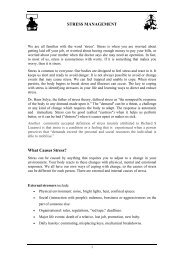
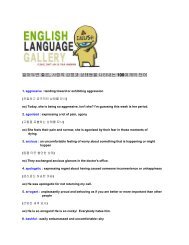
![Finale 2006 - [autumn leaves.MUS]](https://img.yumpu.com/46046993/1/184x260/finale-2006-autumn-leavesmus.jpg?quality=85)

